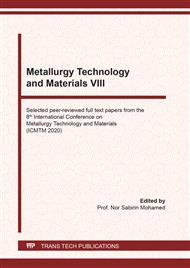[1]
TAUB Alan I, LUO, Alan A. Advanced lightweight materials and manufacturing processes for automotive applications [J]. MRS Bulletin, 2015, 40(12):1045-1054.
DOI: 10.1557/mrs.2015.268
Google Scholar
[2]
Kah P, Pirinen M, Suoranta R, et al. Welding of Ultra High Strength Steels[J]. Advanced Materials Research, 2014, 849:357-365.
DOI: 10.4028/www.scientific.net/amr.849.357
Google Scholar
[3]
IKEDA Rinsei. Weld Joint property and Welding Technologies in Resistance Spot Welding of Ultra-High Strength Steel Sheets[J]. Yosetsu Gakkai Shi/journal of the Japan Welding Society, 2015, 84(6):441-446.
DOI: 10.2207/jjws.84.441
Google Scholar
[4]
Bhole, Khan. A Study of Spot Welding of Advanced High Strength Steels for Automotive Applications[J]. Journal of Iron and Steel Research(International), 2011(s1):724-729.
Google Scholar
[5]
Pouranvari M, Marashi S P H. Critical review of automotive steels spot welding: process, structure and properties[J]. Science & Technology of Welding & Joining, 2013, 18(5):361-403.
DOI: 10.1179/1362171813y.0000000120
Google Scholar
[6]
Mallick P K. Joining for lightweight vehicles[M]// Materials, Design and Manufacturing for Lightweight Vehicles. 2010:275-308.
DOI: 10.1533/9781845697822.2.275
Google Scholar
[7]
Haghshenas M, Gerlich A P. Joining of automotive sheet materials by friction-based welding methods: A review[J]. Engineering Science & Technology An International Journal, 2018, 21(1):130-148.
DOI: 10.1016/j.jestch.2018.02.008
Google Scholar
[8]
Mvola B, Kah P, Layus P. Review of current waveform control effects on weld geometry in gas metal arc welding process[J]. International Journal of Advanced Manufacturing Technology, 2018(10):1-23.
DOI: 10.1007/s00170-018-1879-z
Google Scholar
[9]
Devakumaran K, Ananthapadmanaban M R, Ghosh P K. Variation of chemical composition of high strength low alloy steels with different groove sizes in multi-pass conventional and pulsed current gas metal arc weld depositions[J]. 2015, 11(2):147-156.
DOI: 10.1016/j.dt.2014.11.001
Google Scholar
[10]
T. NYKÄNEN, T. BJÖRK, R. LAITINEN. Fatigue strength prediction of ultra high strength steel butt-welded joints[J]. Fatigue & Fracture of Engineering Materials & Structures, 2013, 36(6):469-482.
DOI: 10.1111/ffe.12015
Google Scholar
[11]
Correard G C, Miranda G P, Lima M S F. Development of laser beam welding of advanced high-strength steels[J]. International Journal of Advanced Manufacturing Technology, 2016, 83(9-12):1967-1977.
DOI: 10.1007/s00170-015-7701-2
Google Scholar


